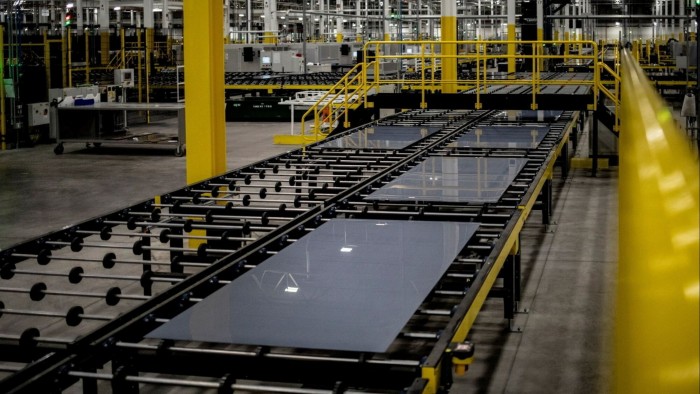Unlock the White House Watch newsletter for free
Your guide to what Trump’s second term means for Washington, business and the world
Donald Trump’s flagship tax bill was predicted to gut the renewables industry, removing Biden-era incentives that helped make green power a major part of the US energy mix.
However, some of the sector’s biggest corporate players say they stand to gain from the flurry of activity triggered by the bill as developers race to source US-made gear and lock in tax credits ahead of looming deadlines.
At its second-quarter earnings last week, First Solar, the largest manufacturer of solar panels in the US, said Trump’s One Big, Beautiful Bill put it “in a greater position of strength” due to a crackdown on Chinese companies.
Under Biden’s Inflation Reduction Act, Chinese solar companies could claim manufacturing tax credits, to the chagrin of their American rivals that accused them of unfair trade practices.
That complaint was answered in Trump’s bill, which introduced Foreign Entity of Concern rules blocking adversarial countries’ companies from claiming credits.
“These restrictions address one of the biggest loopholes under the IRA,” said First Solar chief executive Mark Widmar. “It is not unreasonable to expect there will be limited Chinese solar manufacturing in the US in the foreseeable future.”
The retreat of foreign companies and tariffs also mean that US manufacturers such as First Solar can charge more for their goods amid rising demand for power triggered by the “data centre boom”, said Jeff Osborne, a managing director at TD Securities. The company announced plans to move some of its manufacturing capacity from Malaysia and Vietnam to the US.
“The million dollar question is, what are people going to pay?,” Osborne said. “Rising power prices [are] an enabler to buy equipment at an inflationary price.”
Another bright spot for bigger companies in Trump’s One Big Beautiful Bill is their ability to “safe harbour,” or lock in tax credits for planned projects as long as they are completed by 2030.
While companies can do so by spending 5 per cent of the project’s costs, or starting substantial work by July 4 next year, a July executive order directed Treasury secretary Scott Bessent to tighten these rules to prevent “artificial acceleration or manipulation of eligibility”.
Industry watchers say this is likely to raise costs and competition for materials, and trigger consolidation in the sector.
“There’s real anxiety out there about what this is going to look like,” said Julien Dumoulin-Smith, a power, utilities and clean energy analyst at Jefferies.
Florida-based NextEra Energy, which owns the world’s largest operator of wind and solar projects, said in late July that it expected to capture market share from companies with projects that are no longer viable.
“We compete against a lot of really small developers who don’t have the balance sheet,” said chief executive John Ketchum. “There might be less competition from folks that have not safe harboured.”
The jump in renewables activity might be temporary. Analysts caution that the entire sector is facing an investment chill as developers and utilities pursue gas projects or focus their attention on other countries.
In GE Vernova’s results, chief executive Scott Strazik said that while its wind and solar business has seen an “acceleration of activity”, the bill is a “bull case for gas.”
However, analysts say that demand for renewables is likely to persist. According to Lazard, the cost of utility solar ranges from $38 to $78 per megawatt hour, compared with $48 to $109 per megawatt hour for gas.
“We’ve seen the cost of gas turbines go up immensely in the past year,” said Chris Dendrinos, a clean energy analyst at RBC Capital Markets. “Renewables remain really, really competitive.”


